Sony X80J Reviewed at $750.00 (55")
Product Name: Sony X80J
Product Description: 2021 4K LED LCD TV
-
Design - 8.7/10
8.7/10
-
Video Quality - 8.2/10
8.2/10
-
Ports & Connectivity - 8.9/10
8.9/10
-
OS, Apps and Features - 9.3/10
9.3/10
-
Price / Quality - 9.1/10
9.1/10
Summary
Reviewed at $750.00 (55″)
Pros
- Great viewing angles
- Extremely low input lag
- Dolby Vision and Dolby Atmos support
- Google TV
Cons
- Average contrast ratio
- Brightness output not good enough
- No HDMI 2.1
- No support for VRR and ALLM
Cheapest Places to Buy :
*We are a reader-supported website. When you buy through links on our site, we may earn a small affiliate commission at no extra cost to you. Home Media Entertainment does not accept money for reviews.*
Today’s review marks the beginning of our venturing into Sony’s 2021 TV lineup which has many interesting new models that stretches across the entire price range. And while we are sure many will be drooling over Sony’s top OLED offering that brings with it the new improved OLED panel there are many that are eyeing the lower categories that come with a more down to Earth price. And in our Sony X80J review today we will be looking at the most affordable 4K TV Sony has to offer this year.
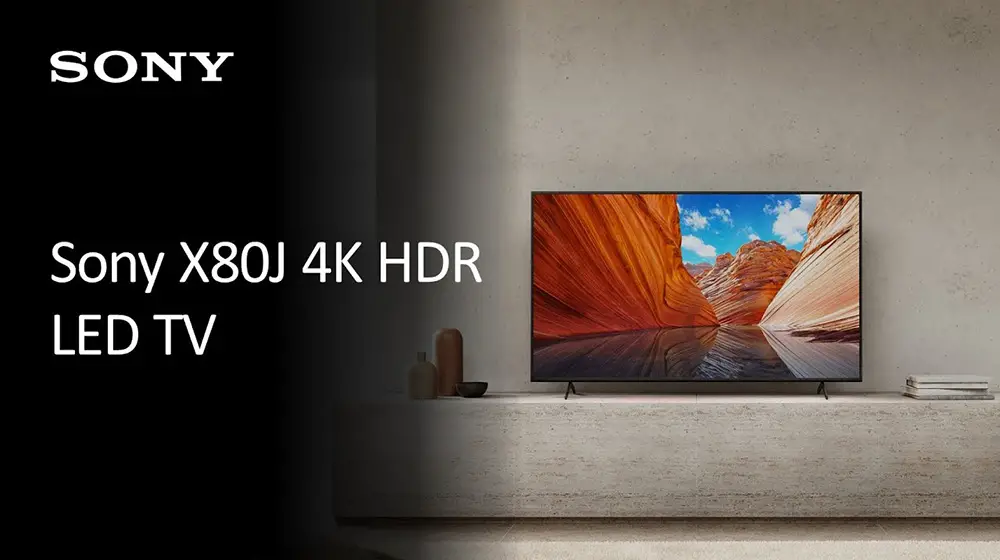
The X80J is your typical entry level 4K HDR TV and is basically replacing last year’s X800H which you can read about in the link. From looking at the specs there are not many differences and it seems that Sony decided to keep things similar in the bottom end of the performance ladder. The X800H had a few good things going for it considering it was a low end offering so we were curious to see if the X80J improved in any particular area at all or we get more of the same.
Obviously there is a huge market that looks for a low cost TV and that’s why Sony is offering this in five different sizes that range from 43″ all the way up to 75″. All sizes come with Direct LED backlight systems and use the X1 4K HDR processor along with a TRILUMINOS Pro display. It supports Dolby Atmos, Dolby Vision and DTS and for OS it comes equipped with the latest Google TV that includes Chromecast and Airplay. Unfortunately there is no HDMI 2.1 and as a result it does not support any gaming centric features.
It is obvious that Sony included only the most basics in the X80J but it all comes down to how all these specs translate into the real world and how do the X80J stacks up against its predecessor. Let’s dig deeper to find out.
Design
The X80J looks and feels like a rebranded X800H as everything seems to be the same in terms of design and overall layout so this part of our review will be similar to the X800H and we will point out the differences wherever needed. Overall the X80J is not bad looking but keep in mind we are talking about a budget model so you shouldn’t expect to find the slick designs we see in the more premium models.
The TV’s overall thickness was measured around 2.8″ (7.2 cm) making it exactly the same as the X800H which is slightly more than what we would like in case that wall mounting is your thing. At least having side looking ports does help in such an occasion as you will not have trouble using them at all with the TV mounted on your wall. The borders are ok for this price but don’t expect the borderless designs of the top tier releases.
The back side of the X80J is also the same as the X800H and is made completely out of plastic. To be honest there is nothing special here as we get a pretty standard and plain design. On the far right are the connection ports, on the far left the power connector and in the middle the VESA wall mount holes. The plastic shell has a very subtle textured surface that somewhat breaks the monotonous look but that’s all there is to it.
Continuing on the similarities the included stand that comes with the X80J is like for like what we found in the X800H. The design follows the fairly standard bench type style that offers the TV more stability but on the other hand you need a bigger furniture if you plan on placing it on one instead of the wall.
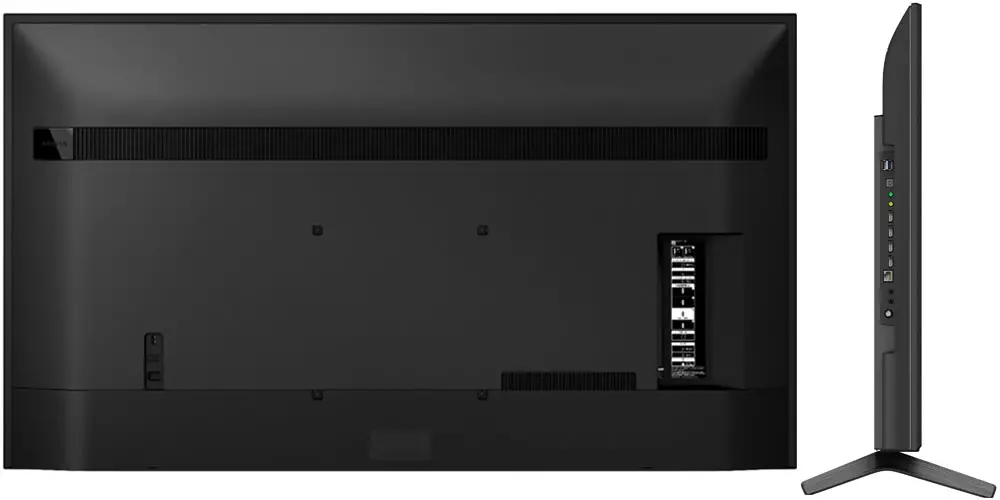
Lastly as far as cable management there are special clips that attach on the back of each leg in order to drive your cables through them instead of having hollow legs like other stands of the same type.
When it comes to their remotes Sony was always playing catch up compared to Samsung and LG. And this was a major complaint we had as even many of their higher tier offerings were using atrocious and old style looking remotes which was unacceptable. Last year Sony finally decided to fix that by redesigning the whole thing and at least now you will get a remote that looks far better and has a more premium feel compared to the cheap remotes we were getting before.
Featuring a grey metal texture the remote that comes with the X80J seem to be extremely similar to the one we used in the X800H but with one small difference this year. The remote is definitely on the large side and has all the functions for smart TV functionality.
The only difference we see this year is instead of only two dedicated buttons for Google Play and Netflix now we have four and these are used for Youtube, Netflix, Disney+ and Amazon Prime video. There is also a Google Assistant button that can be used with the built-in microphone in order to issue your voice commands but in order for that to work it needs to be paired to the TV through Bluetooth. If you pair it then all other commands work without the need for line of sight which is a nice small feature to have.
Everything else is exactly the same and all buttons have a nice feel to them with certain distance from each other to avoid pressing the wrong one but unfortunately there is no backlight function that could greatly help in a low lit environment. In general the remote is an upgrade compared to the one we saw in previous years and Sony seems to keep that well into 2021.

In terms of design there is no change compare to last year. Sony kept X800H’s design into the X80J which is not all that surprising to be honest. Nothing that will wow you really but it has a certain quality that Sony is known for in all their releases.
Video Quality
Processor technology used
Sony tried to include their new Cognitive Processor XR in as many 2021 models as possible but obviously this wouldn’t be possible in the bottom end of their lineup so the X80J comes with the same X1 4K HDR processor that was present in some of their releases last year. And here is another of the similarities we find with last year’s X800H. The X1 processor may be weaker compared to the new silicone from Sony but it is still a very capable chip.
One of its characteristics is Object-based HDR remaster with which the color in individual objects on screen is analyzed and the contrast adjusted, unlike most TVs where contrast is only adjusted along one black-to-white contrast curve. Because objects are remastered individually, this TV can reproduce greater depth, textures, and more real pictures.
There is also Dynamic Contrast Enhancer which automatically adjusts contrast settings according to your environment in order to provide clearer and more defined colors.

And for last we left 4K X-Reality PRO. By using this picture processing technology the X80J is able to up-scale any kind of source content up to 4K with remarkable results. 4K X-Reality PRO is using a variety of noise reduction techniques to sharpen and refine images while patterns in images are compared with patterns stored in a unique database to find the best hue, saturation, and brightness for each pixel.
We tried various types of content in various resolutions in order to see how the X80J can handle the upscaling process and for such a budget friendly unit the TV handled almost everything to a very satisfying extent. Obviously 720p and 1080p resolution content fared the best but even very low resolution video didn’t show any bothering artifacts from the process. Overall we would say that the X80J performed similarly to the X800H in this part.
Lighting technology used
Last year Sony used two backlight systems depending the size of the TV but for the X80J it seems they decided to go for one instead and all sizes go for a Direct LED system without Local Dimming and instead use what they call Frame Dimming.
The Direct LED system is using light behind the included IPS panel but is much less capable than a FALD system which means far less brightness output, less light accuracy and lower contrast which means that blacks will appear for greyish than true blacks. And with the X80J IPS panel low contrast capabilities the omission of Local Dimming makes things even worse.
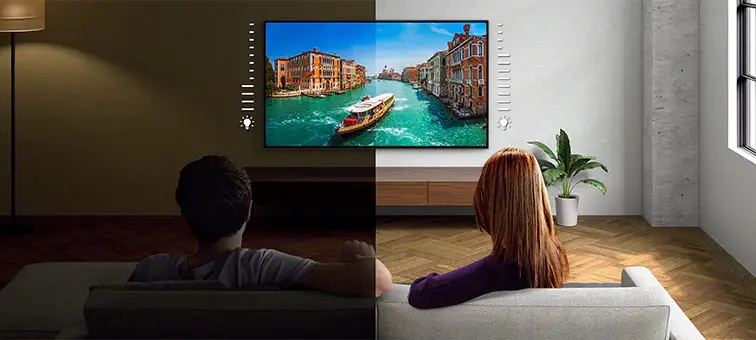
We were not expecting much here as having a Direct LED system is pretty common the last few years in the lower end category and in line with what we have seen in many other TVs with a similar price. At least having an IPS panel in combination with the Direct LED light system makes the X80J much less prone to any major burn-in problems.
Brightness / Contrast
One of the most important characteristics of a HDR TV is no other than its brightness output. It’s unfortunate that many lower tier HDR TVs don’t have the necessary brightness output to make HDR justice even with manufacturers advertising them as such. And with the X80J being at the bottom of the release ladder we cannot say we had great expectations out of it.
In our SDR brightness test we used the Custom Picture mode with Expert 1 color temperature and maximum brightness. In our 10% white window test the X80J was able to output 381 nits of brightness which is ok for SDR content but not as good as the X800H had.
As for our HDR brightness test over a 10% window we managed to get 420 nits which is not very good and cannot create very bright highlights when it is needed. Here the X80J also fared worse than the X800H which is disappointing to say the least.
You can get slightly more brightness with the Vivid mode but this will cost you in color accuracy so basically it is a tradeoff that you have to live with. But to be honest the change is not all that big to show much difference.

In terms of contrast things were not very good either. The 55″ we tested was using an IPS-type of panel and these in general don’t fare very well with black levels. Blacks will appear more grey instead which is a problem that will show its ugly face a lot if you are watching in a low lit room. The 50″ size that is using a VA should in theory have better contrast but at the time of writing this review we could not confirm this.
Viewing angles
Here things are not much different from last year. The X80J is using an IPS-type of panel and this usually means good things when it comes to its viewing angles especially in comparison to TVs that come with VA panels. The X80J is not featuring any wide viewing angle technology that could potentially improve even further its performance in this regard but for an LCD TV they are very good. Not OLED good but no LCD TV can do that good even with some added layer that is used to improve this.
From what we saw the X80J retained image quality up to about 40 degrees of angle which can be considered very good making this model ideal for family rooms where many people will be watching from different angles. Anything more than that and the overall quality starts to degrade a lot. But to be honest anything more than that will make viewing rather difficult to begin with so this shouldn’t be a problem at all.
Keep in mind that the 50″ size seems to be using a VA panel instead of an IPS one and this means that the 50″ size should fare worse in this regard. Why Sony went for a VA panel for this size is unknown but it’s something to consider when choosing your appropriate size.

HDR support
For 2021 Sony decided to include all the supported HDR formats in all their releases. This means that even the most budget friendly 4K X80J model we have here gets some Dolby Vision love. Now the limited capabilities of the X80J cannot really show Dolby Vision as it was meant to and to be honest it feels more like a marketing thing than a real feature that adds major value to the X80J specifically.
In total the X80J features the standard trio of HDR protocols that include the basic HDR10 which is required for 4K UHD playback, HLG that is used in broadcasting and lastly the more advanced Dolby Vision that uses dynamic metadata and offers the best quality from the three available.
We have said before that Sony does not seem eager to support HDR10+ and this continues well into 2021 with no signs of this changing any time soon so if you expect HDR10+ from Sony don’t hold your breath yet.
Color coverage
The X80J comes with wide color gamut support which is one of the fundamental requirements for HDR content viewing as it can make the colors look more vivid and lifelike. The X80J includes all the same technologies that allow it to achieve such a wide color spectrum. One of these technologies is what Sony calls a TRILUMINOS display which is a technology that the TV uses in order to display a wider color palette and more natural shades and hues.

The difference we see this year is that the X80J is using a Triluminos PRO display instead of the Triluminos display the X800H had so we were curious to see if there is any noteworthy difference in terms of color reproduction in these two.
So for the X80J specifically we measured a 89% coverage in the DCI-P3 color space which is great and is almost the same as what we had measured in our X800H testing. On the more wide REC.2020 color space we got a coverage of 66% which seems to be slightly lower than the X800H but just what you would expect from such a low cost TV.
To be honest seeing the Triluminos Pro display made us hope for even a slight improvement here but not only we didn’t see any, the numbers were also slightly worse than last year. Small difference but it was there.
Motion performance
Sony is known for their excellent motion performance in most of their releases so we were curious to see how the X80J can do in this department. Things are not all that different from last year and the TV seems extremely similar to the X800H as it is using a 60Hz panel (or 50Hz depending on your region) so nothing out of the ordinary for this kind of category. We again find exactly the same Motionflow XR 240 technology which is Sony’s take on smoothing out the motion of the screen.
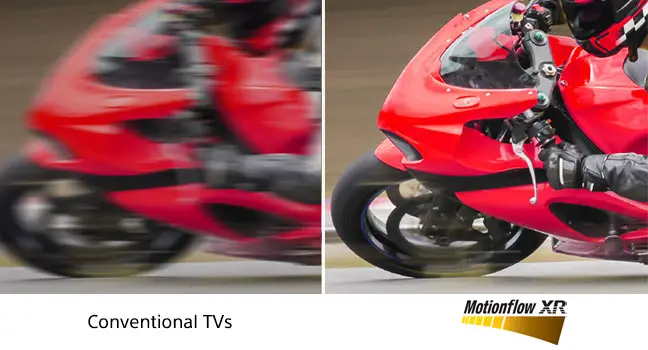
You have the option to use either the standard motion interpolation system or use the Black Frame Insertion (BFI) interpolation that is adding black frames in between individual frames and can potentially smooth out motion. BFI can be enabled by turning Clearness to max if you use the Custom setting in the MotionFlow menu. BFI did help with slightly smoothing the motion but the TV had exactly the same image duplication issue we had seen in the X800H. It is not so obvious and certainly not to such a degree to become overall bothering but it was there for those that pay attention. And keep in mind that in general BFI has also a negative effect on brightness due to the black frames that are inserted.
Lastly in a similar fashion to the X800H, the X80J does not support any kind of VRR technologies either it be HDMI Forum VRR, FreeSync or G-Sync. So if any of these are really important to you then you will have to look at least for the X85J or above.
The X80J was more or less the same with the X800H. Motion was good enough, motion interpolation and BFI had their strengths and weaknesses and we didn’t see any major change from Sony here.
Input lag
Next is our the input lag measurements. We can admit that TVs, even low tier ones, have really amazed us the last couple of years as they have achieved input lags that measure into single digits. The X800H we had tested before came at 11.1 ms so we were curious to see if the X80J would be close to that and indeed it was. The number we got was 12.1 ms which is really good and very close to what we saw last year.

This measurement is an average of 1080p and 4K resolutions with the available Game mode turned on. When we turned off the Game mode the input lag spiked to 133.5 ms which may be too much for demanding gamers but can still provide a satisfying experience for casual gamers and slow paced games. Unfortunately as the X80J is missing an HDMI 2.1 port this means that certain, gaming centric, features are missing also. And this is no other than Auto Low Latency Mode (ALLM) which could be of real benefit with the new gaming consoles released. For that you will have to look at the X85J instead.
During our live testing with a PS5 and the game F1 2019 everything felt smooth as butter. Our commands were registering extremely fast with no lag or delay so even if the TV doesn’t have either VRR or ALLM its response will please even the most demanding of gamers.
Image quality impressions
With so many similarities in specs we were expecting the X80J to perform at least on par with the X800H but while in many cases this was true there were a few areas that the X80J didn’t do so well in comparison.
The TV has good upscaling capabilities for its price, very low input lag, similar viewing angles and adequate motion performance. But we measured slightly lower color coverage and worse brightness output in both SDR and HDR. And if you take into consideration the sub-par contrast in terms of image quality the X80J fails to impress.

Also this model is missing HDMI 2.1 along with all the new features this brings like ALLM and VRR. In total it is not a bad TV but it’s not a model that will impress you with its quality of image. And in comparison last year’s X800H comes slightly above this one.
Audio Quality
Next is our audio testing and here things seem very similar in terms of the hardware used as the X80J is using a standard 2.o channels audio system with 20 watts of total power. But what Sony has done here is that by using a bass reflex system along with their X-balanced speakers, as they call them, they have tried to improve the overall output without changing much in terms of the audio setup being used.
This X-balanced speaker is basically a specially shaped driver in order to provide the best audio result possible for the slimline factor of the TV. Obviously going for a round driver would have a negative effect on the overall TV thickness while an oval driver compromises sound quality. The specially shaped X-balanced driver combines the best of both worlds, at least according to Sony.
We tried various content on the TV ranging from talk shows, sports, TV series, movies and more and overall we got a very clear representation that it can do well in terms of casual use. Yes, it cannot provide much immersion in movies and will not throw you right into the action but we didn’t hear any audible problems either. Clear dialogue with normal distortion across the entire frequency range.
It’s a bit surprising to be honest to find Dolby Atmos support along with Dolby Audio and DTS as the TV doesn’t really have what it takes to faithfully reproduce Dolby Atmos. All action is firmly positioned at the front, there is no major overhead activity while surround effects were completely missing. We hate when manufacturers are using Dolby Atmos for promotion when the hardware required to perform accordingly is simply not there. At least with the included eARC port you can pass-through the signal to an external audio device that can do Dolby Atmos and DTS:X real justice.
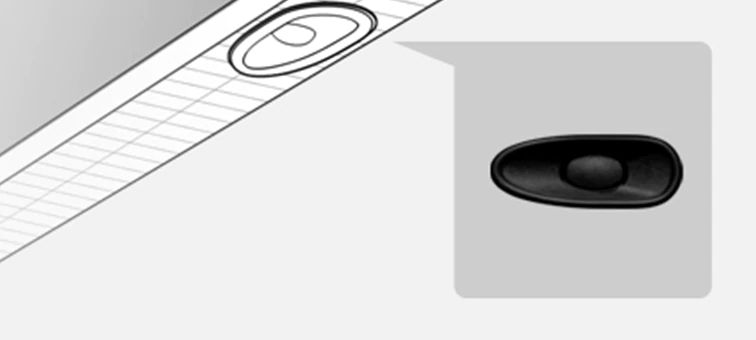
Ports and Connectivity
Another area where we find minimal changes is in the connection ports. All of them are grouped together in a special inset on the right side of the back panel. All of the ports are looking sideways and this definitely helps in case you want to wall mount the TV as the ports will be free to use.
Going from top to bottom we get two USB ports for connecting external storage or powering various devices, a digital optical audio output for connecting older equipment that does not support HDMI connections, an analogue stereo audio output for headphones, a composite video input, four HDMI ports for connecting all your devices, an Ethernet port for wired connection to your network, an RS-232C port for control, an IR input and the usual antenna/cable connector.
The X800H used to have a USB 3.0 port and Sony decided to keep that in the X80J also. Usually manufacturers don’t seem very fond of using the newer USB ports and rely mostly on the archaic 2.0 version even for many of their top premium models so seeing the X80J, which is such a low cost TV, getting one USB 3.0 is definitely a cut above what most other manufacturers offer.
Also another thing to mention is that all HDMI ports are the older 2.0b variant. The X80J is the only Sony 4K TV that does not support HDMI 2.1 at all and you will have to look at the next in line model, the X85J, if you absolutely need this. Thankfully Sony at least decided to upgrade the HDMI ports and give us eARC that was missing last year. This way the X80J can at least pass-through both Dolby Atmos and DTS:X audio to equipment that support these.
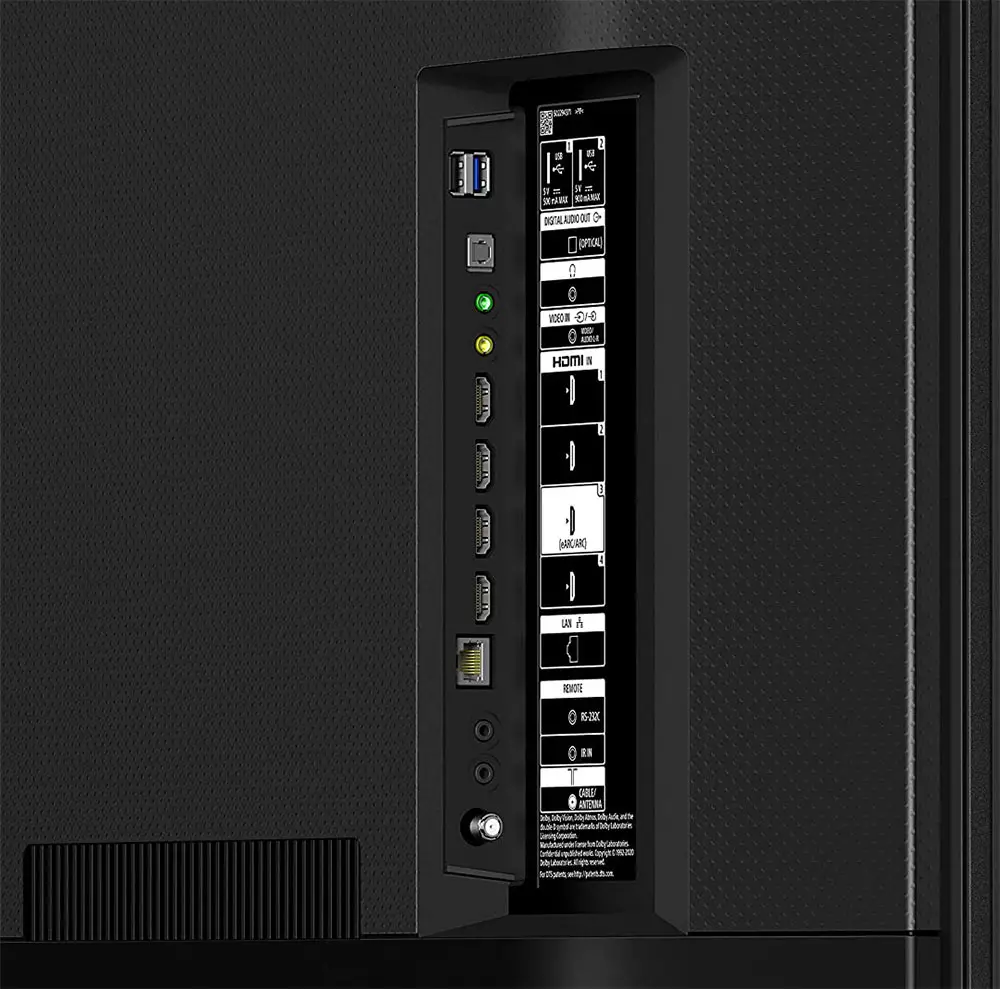
In terms of wireless capabilities things are pretty much the same as all other Sony releases so the X80J comes with built-in WiFi (802.11ac) along with Bluetooth v4.2. We would like to see the newer Bluetooth 5.0 but it seems that Sony is still stuck to this older version.
Not many changes here. Not having HDMI 2.1 is not very surprising considering the low cost nature of the X80J but the inclusion of eARC will certainly please many.
OS, Apps and Features
Up until last year Sony’s TVs were using Android TV as their OS and although the last few versions had major improvements compared to the first version of the OS it never managed to reach the greatness of Tizen or webOS. For 2021 we see a bigger change as Sony decided to include Google TV instead.
Now many of you may be puzzled what the difference between Android TV and Google TV is. Well, it’s not so much difficult to understand what has changed really. Google TV is still Android TV but with an extra layer on top of it. Think of it like it is in Android smartphones. Most manufacturers that use Android in their releases they use on top of that their own layer that gives this extra something to their UI that make them unique both in appearance and functionality.
The same is with Google TV. You still basically use Android TV but there is the extra Google TV layer on top in order to make the UI feel different both in looks and functionality. The 2021 TVs from Sony that use Google TV have at their core the latest Android TV 10.0 but the Home screen has been completely changed due to the new Google TV layer.
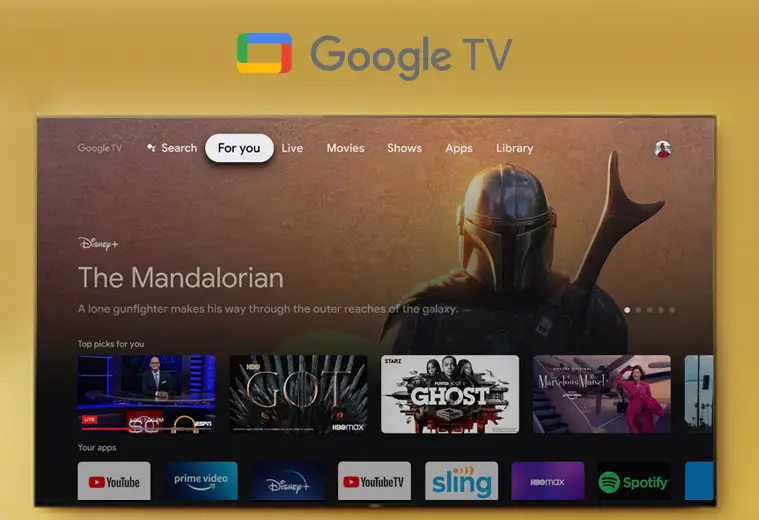
Everything now seems to have been designed around recommendations either it be movies, TV shows or applications and this seems to be the main focus of the new Google TV in general. During setup the wizard asks you of what specific streaming services you use in order to customize the Home screen recommendations.
Keep in mind that Google TV is still Android at its core even though it looks different. But with Google TV things seem more fluent, more direct and more easy to navigate around.
If there is one thing that Android has in abundance that is huge app support. Through the included Google Play Store you can find literally thousands of apps that you can download and use except from the pre-installed ones. There is so much content available that you will definitely find the ones you are looking for and the list goes on and on.
All the big names are obviously present like Google TV, Disney+, Netflix, Amazon Video, Hulu and Youtube as well as Pandora, Tidal, Google Play Music, Spotify or iHeartRadio. As always some of them are region dependent so make sure the ones you are interested in are working in your area. Lastly certain apps like Netflix and Youtube support playback for both 4K and HDR content for those interested in it.
Chromecast is also available here and it gives you the ability to stream content from other Chromecast enabled devices like mobile phones and tablets directly to the TV. Voice control is also present but it seems that it is a bit limited compared to other competing models. By that we mean that although you can use the remote’s built-in microphone to give commands to Google Assistant for Amazon Alexa you will need an external Alexa enabled device to work. Additionally there is also Sony’s Voice Search available.

We have seen the same thing in many other Sony TVs and probably this has to do with the fact that it’s using Google’s Android system and thus having Alexa built-in was not possible. With voice control you can issue various commands to the TV but functionality extends far beyond that as you can control any smart devices you have in your house also.
There is also a built-in media player available that you can use to playback various video and audio content from an external storage connected to the USB ports. Support is pretty good for a built-in player and compared to the competition we can admit that it will be able to play more files in comparison but in general don’t expect it to replace your dedicated media player box if you use one. If there is a file that is not following the usual standards it will not play it something that a dedicated player might will.
As always we did try a set of different files that had different resolutions and various codecs and most of them had no problem either to start or playback fluently. Some that were not so standard refused to play but these will be the rare case and not what you should expect most of the times.
Sony has also added support for both Apple Airplay 2 and HomeKit. With Airplay 2 you can stream content from other Apple devices on your TV while HomeKit lets you control certain aspects of the TV through your mobile device. Also if you are all Apple then keep in mind that the X80J supports Apple TV which is Apple’s online streaming service in order to have the complete Apple’s suite. So in case you favor Apple’s products the X80J will certainly cover you in this respect.
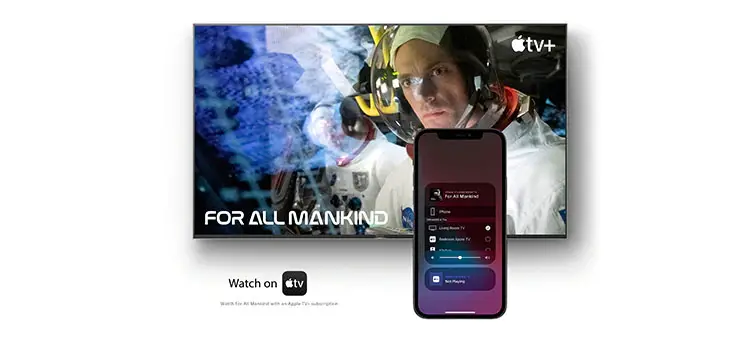
This year all Sony TVs are Calman Ready although to be honest we fail to see how this can benefit the low performing X80J. To address color variations from the production process, the TV is ready to use Portrait Displays’ high-performance Calman auto-calibration software. This allows an unprecedented level of calibration and the ability to fine-tune adjustments simply not possible through conventional picture settings. It delivers high-fidelity color reproduction that’s true to the original TV signal, and can even adapt to the subtlest changes in color that may occur over time.
One last thing we need to mention is that there is no official app support for controlling the TV. If you want to control the X80J using your mobile device you can use the Android TV app made by Google that supports many of Sony’s TVs the last few years. It’s nothing major but can be a nice alternative to the included remote if you want to have more options.
Being the most budget friendly TV this year meant that the X80J is using the basic set of features that all other TVs have. It’s missing a few more specialized functions but in general it has everything a smart TV needs. And the inclusion of the new Google TV will certainly please many potential buyers.
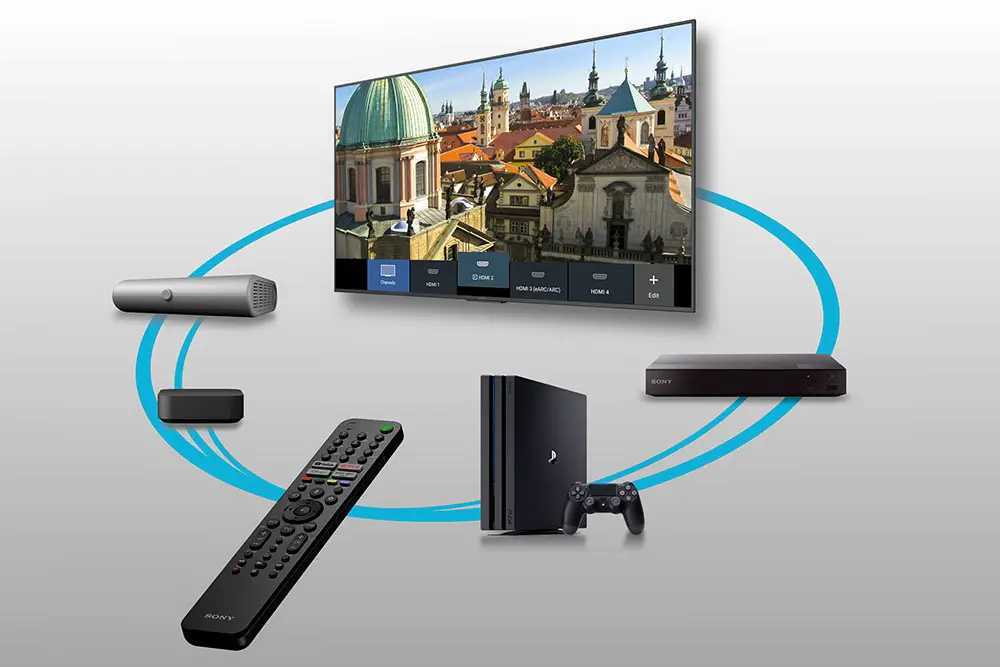
Final Thoughts
Sony really have turned more than a few heads with some of their new 2021 releases. Unfortunately in the case of the X80J the unit cannot escape its low cost nature. The TV is essentially a rebranded X800H but not without a few notable differences.
The inclusion of the X1 4K HDR processor meant that in general its upscaling capabilities are excellent and it will turn any content into 4K with great results. Using an IPS like panel means that it is an excellent family TV as viewing angles are great for an LCD TV and its extremely low input lag can make this a great low cost gaming TV. Along you get a few nice extras like Dolby Vision and Dolby Atmos support, solid motion performance and the new Google TV that feels much better than previous Android TV versions.
On the downsides its brightness output is not good at all and it cannot really make HDR content pop the way it should. Also its contrast is mediocre to say the least with blacks appear more grey than they should. And if you consider that last year’s X800H had better brightness along with slightly better color reproduction adds more insult to the wound. Audio wise the simple 2.0 channels system will suffice only for casual use and although there is Dolby Atmos support don’t expect anything major out of it. Lastly this is the only 4K TV from Sony this year that does not have HDMI 2.1 along with VRR and ALLM which stinks if you are an avid gamer.
For a low cost TV the Sony X80J is not a bad one if you are well aware of its limitations. If you are looking for an absolute low cost 4K TV meant for casual use then the X80J will certainly fit the bill, just don’t have any expectations in terms of image quality and HDR performance.
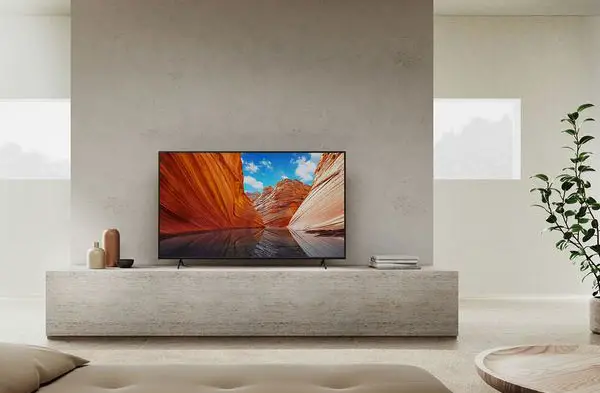
For more reviews you can check our dedicated 4K LED LCD TV reviews list or even look at our Product Reviews Table where you can find the brand and specific product you are looking for.
Cheapest Places to Buy :
*We are a reader-supported website. When you buy through links on our site, we may earn a small affiliate commission at no extra cost to you. Home Media Entertainment does not accept money for reviews.*
Hi. Thanks for your review. I was looking for a cheap TV for my mother and the X80J since like a good option. I don’t want to go for those unknown brands but since it’s my mother she doesn’t have much expectations out of it. Just a TV that will work without problems.
Well Dominique. In that case the X80J really does fit the bill!
Thanks so much for the Sony X80J review. Μuch needed. We are looking for a low cost TV and since I always favored Sony I will surely look at what they have first. To be honest I have no need for the HDMI 2.1 input so it’s not a deal breaker to me. Thanks a lot for this thorough review!
If you don’t have much expectations Sunny and you just want a cheap TV to work with the X80J is not a bad choice to be honest. But just don’t expect much more.
Honest review. Very clear from your words unlike other paid people.
Thank you Ejaz. We always try to offer honest reviews no matter the brand.
My region has 50hz. IN US 60hz.. does that mean the panel altogether is different?
No. There is no difference at all. It’s just the frequency difference depending on the region you live.